Indonesia Textile Market Size
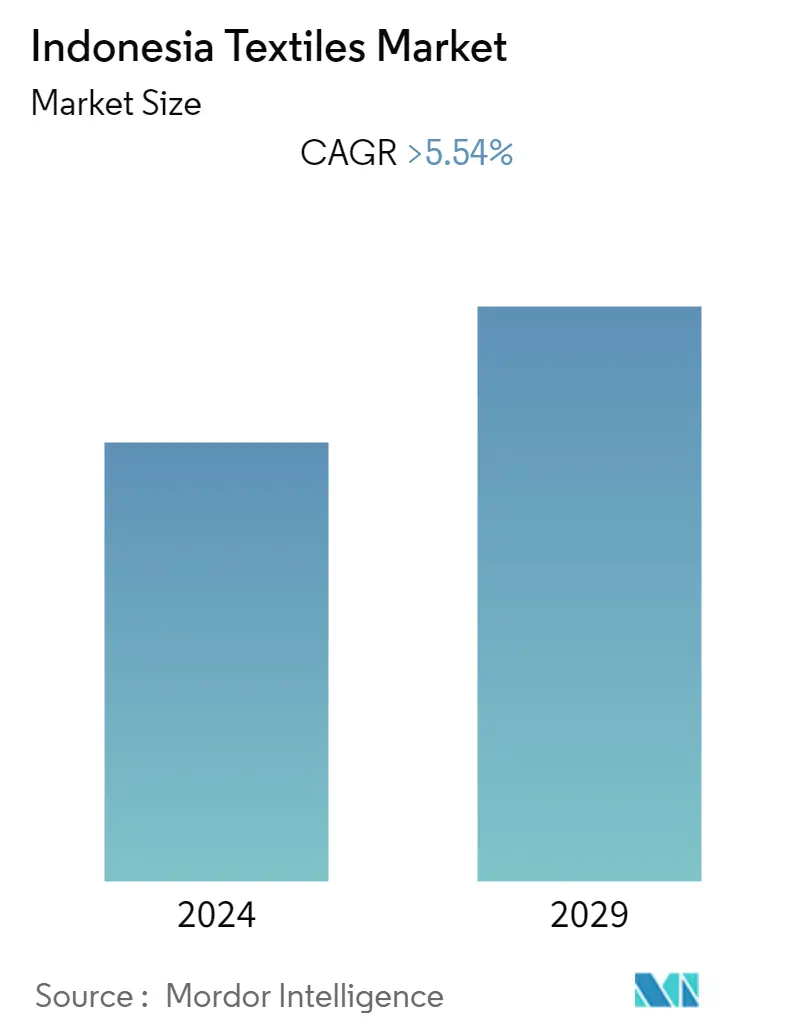
| Study Period | 2019 - 2028 |
| Base Year For Estimation | 2022 |
| Forecast Data Period | 2024 - 2028 |
| Historical Data Period | 2019 - 2021 |
| CAGR | > 5.54 % |
| Market Concentration | Low |
Major Players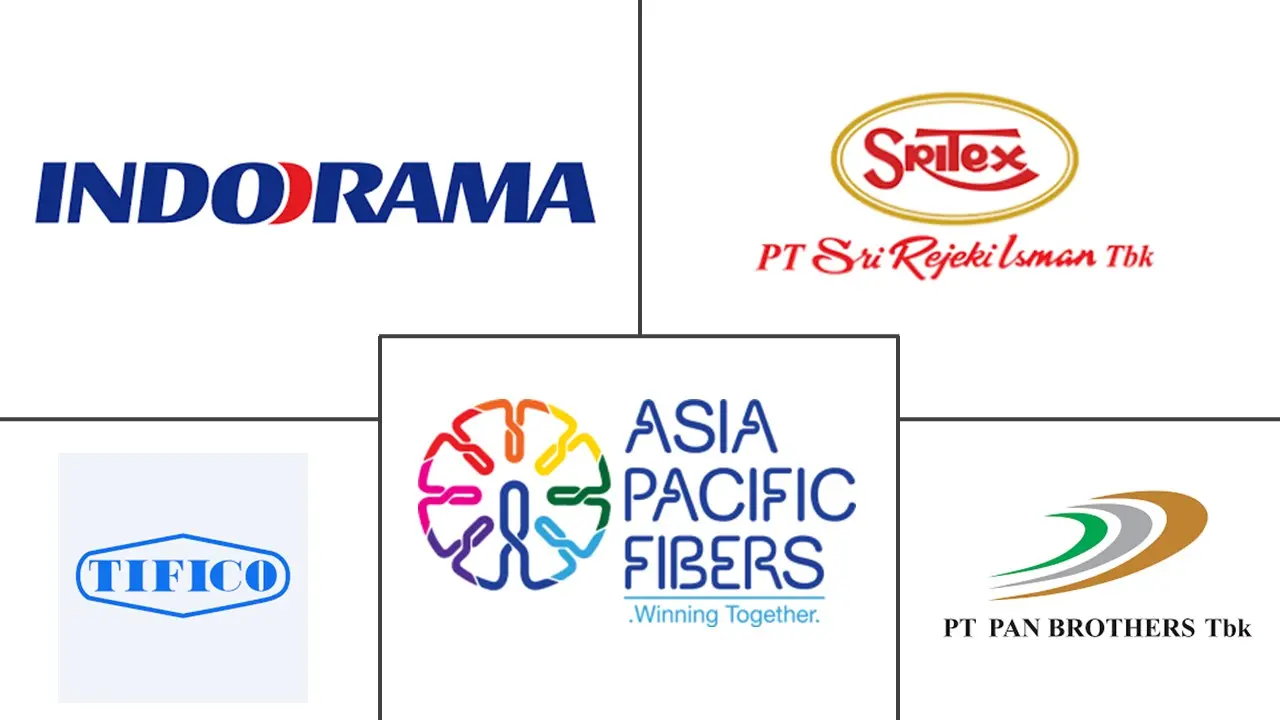
*Disclaimer: Major Players sorted in no particular order |
Need a report that reflects how COVID-19 has impacted this market and its growth?
Indonesia Textile Market Analysis
The size of Indonesia's Textile market is USD 13.1 billion in the current year and is anticipated to register a CAGR of over 5.54% during the forecast period.
- As per experts, by 2022, the clothing sector in Indonesia is predicted to rise by about 10.45%. The demand is barely 75% of its pre-COVID levels, though. In recent decades, Indonesia's modest apparel market has experienced tremendous growth. Modest fashion has emerged as a fascinating subject among the wearers of the modern world. Indonesian modest fashion encompasses a variety of trends and styles. It draws inspiration from global elements while retaining a regional heritage and feels.
- Indonesia's membership in the trade agreement known as the Regional Comprehensive Economic Partnership (RCEP) has received approval from the country's parliament. The nation anticipates increased trade and FDI in several industries. Although the government's policies might not support cooperation within the bloc, the Indonesian textile industry may also hope for increased investment.
- Indonesia is a significant supplier of textile goods to several RCEP member nations, including Australia, Japan, New Zealand, South Korea, and Singapore. Indonesia would have improved access to member countries' markets with RCEP membership. It implies that the textile industry in Indonesia may anticipate increased exports. However, given that Indonesia has adopted a strategy to prohibit the export of raw materials and intermediary products, synergy may not develop among the bloc's textile-exporting nations. The RCEP nations that compete with the Indonesian textile industry are Thailand, Vietnam, Myanmar, the Philippines, and Cambodia.
- According to the West Java Province Textile Product Businesses Association (PPTPJB), 14 West Javan cities and regencies have received complaints of worker layoffs. Sixty-four thousand employees from 124 textile companies were put off two weeks ago. The reduction in consumer spending, notably in the biggest export-destination nations like the United States and Europe, led to layoffs. The demand in one of the factory outlets in Bogor Regency has decreased by 50% since April 2022. The circumstance has become challenging. The market fluctuated in the months that followed before falling as much as 70%.
Indonesia Textile Market Trends
This section covers the major market trends shaping the Indonesia Textiles Market according to our research experts:
Increase in exports is driving the demand
The Indonesia Bureau of Statistics reported that in 2021, Indonesia was the world's 13th-largest exporter of modest clothing. Its market value is USD 4.68 billion. It is around 12.49% greater than in 2020. Indonesia exported clothing valued at approximately USD 4.16 billion in 2020. From January to May 2022, Indonesia exported modest clothing worth USD 2.35 billion, up 4.42% from the same period in 2020. The Fashion division is expected to generate at least USD 9.30 billion in revenue in 2022. The most significant market volume, estimated at USD 312.20 billion in 2022, is in China, where most profits are made. Nearly USD 105.60 is the average revenue per user (ARPU).
The textile sector is witnessing a modest resurgence in demand for their products from key export destination nations by the local and global economic recovery. According to the Ministry of Industry (MOI), exports of textiles and textile products climbed by 19% to USD 10.52 billion from January to October 2021. In addition, the investment value of the sector rose by 12% to 5.06 trillion IDR, or USD 353.7 million.
According to the MOI, the textiles and textile-related products industry had an average utilization rate of 60% in 2021. However, the upstream and intermediate industries' utilization rates are anticipated to rise to 75% by the end of 2022, while the garment industry's utilization rate is expected to reach 85%. Consequently, MOI predicts that the textile industry will expand by 5% in 2022.
Despite these opportunities, the cost of production, notably labour, energy, and raw materials, is a problem for Indonesia's textile sector. Because cotton is still significantly more expensive than synthetic materials, clothing for middle-class and upper-class consumers is often made from cotton fibre. In contrast, apparel for middle-class and lower-class consumers is typically made from rayon, polyester, and fibre blends. Furthermore, practically all of the polyester and rayon used by the textile industry are manufactured domestically, making them easier to obtain than cotton. In contrast, 99% of the cotton the industry uses is imported. Nevertheless, when the effects of the pandemic limitations fade and the economy improve, there will be an increase in demand for cotton clothes to satisfy the needs of consumers returning to the office, school, and other public settings.
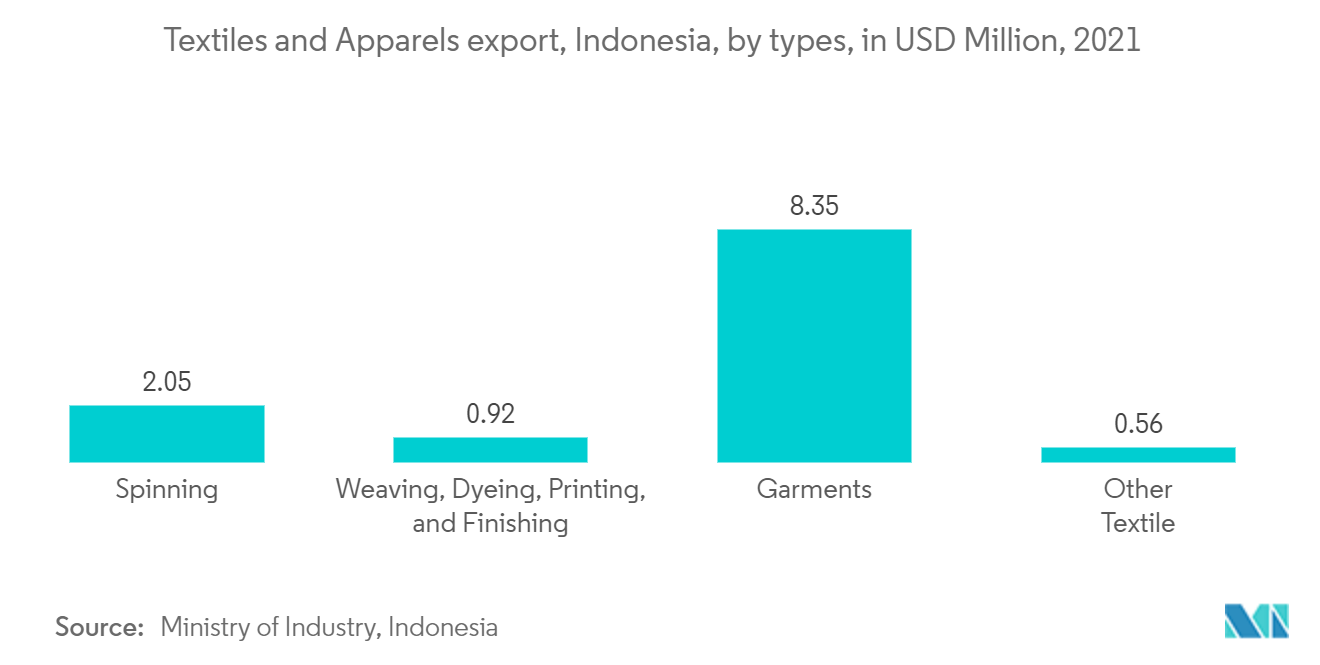
High demand of fabrics is expected to drive the market
In the first quarter of 2022, the apparel industry's production volume may increase by 10.44% annually. The demand will most likely only increase to 75% of its pre-COVID levels. Masitoh continues, In Q2, FY2022, the amount of Indonesia's apparel industry production is projected to slow to 10.15% on an annual basis.
The clothing industry's growth slowed to 0.16% in Q4 of FY2022. But in 2022, Indonesia's apparel sector will experience yearly growth of 5.84%. In Q4 FY2022, it is anticipated that the textile or apparel raw material industries will have a fall of 1.02%. Beginning in July 2022, the textile industry will expand, while the apparel sector will experience two surges of demand in 2023.
In Indonesia, the apparel and garment sector supports the livelihoods of almost 2 million people, according to data from the International Labor Organization. The risks associated with global inflation and the current geopolitical situation are also having an impact on the apparel manufacturing industry. The central bank of Indonesia revised its forecast for full-year economic growth downward in April, from 4.7% to 5.5% to between 4.5% and 5.3%.
China is facing increased international pressure over the treatment of people in its far-western region of Xinjiang, which could hurt the country's textile industry and potentially increase the export chances for other Asian nations like Bangladesh, Indonesia, and Vietnam. Cotton and other goods with Xinjiang ties will soon be prohibited, according to US customs.
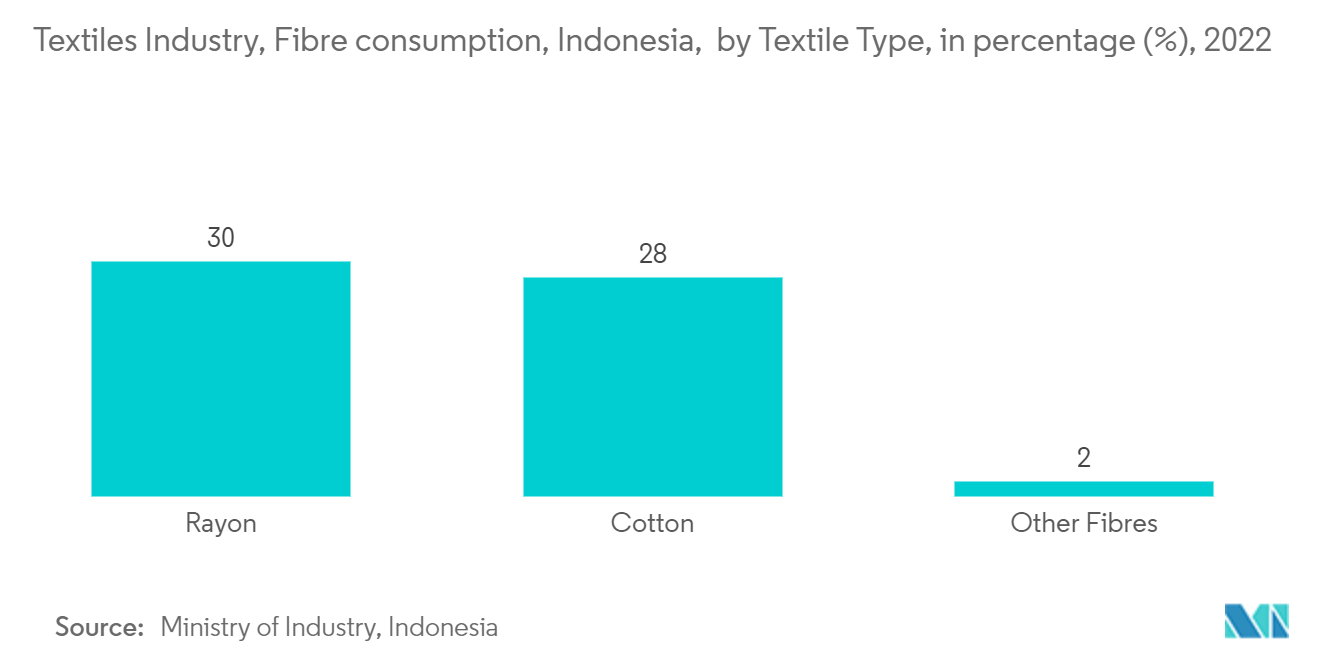
Indonesia Textile Industry Overview
The Indonesian textile industry is highly fragmented, with many local and international players in the market. The key players in the polycarbonate market are PT. Sri Rejeki Isman Tbk, PT. Asia Pacific Fibers Tbk, Indorama Corporation (PT. Indo-Rama Synthetics Tbk), PT. Pan Brothers Tbk, and PT. Tifico Fiber Indonesia Tbk, among others.
Indonesia Textile Market Leaders
PT Sri Rejeki Isman TBK
PT Asia Pacific Fibers TBK
Indo-Rama Synthetics TBK
Pt Pan Brothers TBK
PT Tifico Fiber Indonesia TBK
*Disclaimer: Major Players sorted in no particular order
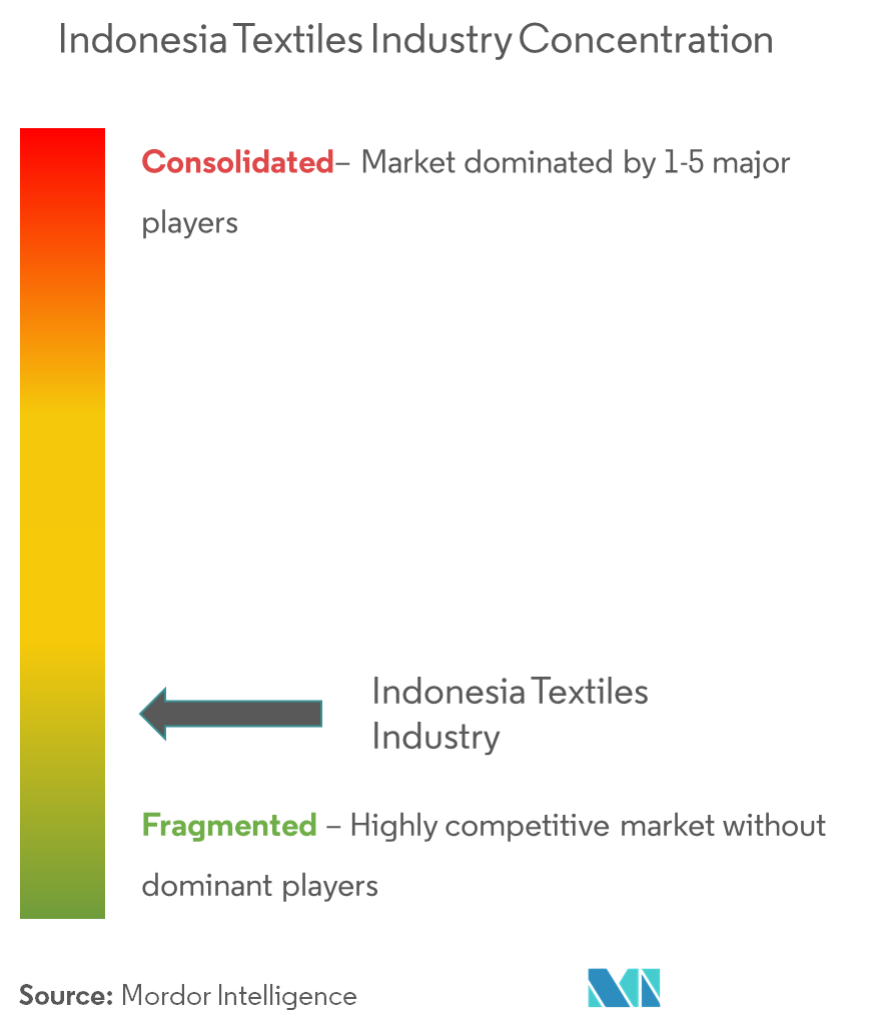
Indonesia Textile Market News
September 2022: The Pt. Trias Toyobo Astria (TTA), located in Indonesia, will house a new polyester film packaging facility that will be opened by the Japanese textile business Toyobo. To fulfill the growing need for sustainable film products, Toyobo and the Indonesian film company Pt. Trias Sentosa, Tbk formed TTA. The facility, which will cost JPY10 billion (USD 72 million), would increase TTA's production capacity twofold. The plant will start operating by the end of 2025 once Toyobo builds on it in the spring of 2024.
September 2022: South Korean fashion company operator SBW Group has entered the bidding war to acquire The Lycra Company, a leading global textile company. The organization has recently failed in acquisition offer attempts for Korean companies, including Ssangyong Motor Co. and Eastar Jet Co. It is also the subject of various criminal investigations, leading market observers to question the purchase plan.
Indonesia Textile Market Report - Table of Contents
1. INTRODUCTION
1.1 Study Assumptions
1.2 Scope of the Study
2. RESEARCH METHODOLOGY
2.1 Analysis Method
2.2 Research Phases
3. EXECUTIVE SUMMARY
4. MARKET INSIGHTS & DYNAMICS
4.1 Current Market Scenario
4.2 Market Overview
4.3 Market Dynamics
4.3.1 Drivers
4.3.2 Restraints
4.3.3 Opportunities
4.4 Value Chain / Supply Chain Analysis
4.5 Industry Attractiveness - Porter's Five Forces Analysis
4.5.1 Threat of New Entrants
4.5.2 Bargaining Power of Buyers/Consumers
4.5.3 Bargaining Power of Suppliers
4.5.4 Threat of Substitute Products
4.5.5 Intensity of Competitive Rivalry
4.6 Technological Advancements in Textile industry
4.7 Pricing Analysis and Revenue Analysis of Textile Market
4.8 Impact of COVID-19 on the market
5. MARKET SEGMENTATION
5.1 By Application
5.1.1 Clothing
5.1.2 Industrial/Technical
5.1.3 Household
5.2 By Material
5.2.1 Cotton
5.2.2 Jute
5.2.3 Silk
5.2.4 Synthetics
5.2.5 Wool
5.3 By Process
5.3.1 Woven
5.3.2 Non-woven
6. COMPETITIVE LANDSCAPE
6.1 Overview
6.2 Company Profiles
6.2.1 PT. Ever Shine Tex Tbk
6.2.2 PT Trisula Textile Industries Tbk
6.2.3 PT Century Textile Industry Tbk (Toray Industries Inc.)
6.2.4 PT Pan Brothers Tbk
6.2.5 PT Polychem Indonesia Tbk
6.2.6 PT Sri Rejeki Isman Tbk
6.2.7 PT Indo Kordsa Tbk
6.2.8 PT Tifico Fiber Indonesia Tbk
6.2.9 PT Panasia Group
6.2.10 PT Asia Pacific Fibers Tbk
6.2.11 PT Tyfountex Indonesia
6.2.12 PT Eratex Djaja Tbk
6.2.13 PT Argo Pantes Tbk
6.2.14 Indorama Corporation (PT. Indo-Rama Synthetics Tbk)*
- *List Not Exhaustive
7. MARKET OPPORTUNITIES AND FUTURE TRENDS
8. APPENDIX
Indonesia Textile Industry Segmentation
Any substance made of woven threads is a textile. It has numerous uses and many different forms. Textiles are probably a part of everyone's surroundings or circumstances. Textiles are used in various products, including clothes, furniture, bedding, carpeting, and even automotive parts.
A complete background analysis of the Indonesia Textiles Market, including the assessment of the economy and contribution of sectors in the economy, market overview, market size estimation for key segments, and emerging trends in the market segments, market dynamics, and geographical trends, and COVID-19 impact is included in the report. The Indonesian Textiles Market is Segmented by Application Type (Clothing Application, Industrial/Technical Application, and Household Application), By Material (Cotton, Jute, Silk, Synthetics, and Wool), and By Process (Woven and Non-woven). The report offers market size and forecasts for the Indonesian Textiles Market in value (USD billion) for all the above segments.
| By Application | |
| Clothing | |
| Industrial/Technical | |
| Household |
| By Material | |
| Cotton | |
| Jute | |
| Silk | |
| Synthetics | |
| Wool |
| By Process | |
| Woven | |
| Non-woven |
Indonesia Textile Market Research FAQs
What is the current Indonesia Textiles Market size?
The Indonesia Textiles Market is projected to register a CAGR of greater than 5.54% during the forecast period (2023-2028).
Who are the key players in Indonesia Textiles Market?
PT Sri Rejeki Isman TBK, PT Asia Pacific Fibers TBK, Indo-Rama Synthetics TBK, Pt Pan Brothers TBK and PT Tifico Fiber Indonesia TBK are the major companies operating in the Indonesia Textiles Market.
Indonesia Textile Industry Report
Statistics for the 2023 Indonesia Textile market share, size and revenue growth rate, created by Mordor Intelligence™ Industry Reports. Indonesia Textile analysis includes a market forecast outlook to 2028 and historical overview. Get a sample of this industry analysis as a free report PDF download.
